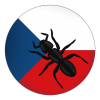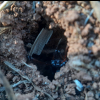CT ant keepers unite!!! lol, just kidding. Anyways, awesome journal! like how everything is neat and organized
Yay, first comment! #ctanterswilltakeovertheworld
I learned that my "Lasius Interjectus" group was actually Lasius Nearcticus. One of the alate pupae eclosed today!
Also, I flipped a huge rock and saw a clueless Formica Subseriscea queen staring back at me amongst thousands of workers. A worker soon dragged her away (I considered catching her and the colony but I realized that I'm not prepared for keeping a large colony of a large ant).
Yeah, I've noticed that F. subsericea queens aren't exactly the sharpest tools in the shed. While lifting large stones to look for founding chambers, I came across a massive F. subsericea colony. The brood was carried away instantly, but the queen just stood there for a second, then ran AWAY from the nest. I tried to catch her to put her back in the colony, but failed. I guess she found her way back on her own, because when I lifted the rock again a few days later, the exact same thing happened, except this time I was able to get her back to the colony. Once she was back at the entrance, she just stood there until a worker dragged her back into the nest.
I guess when other queens lose their maternal instincts, formica queens lose all their instincts.






















